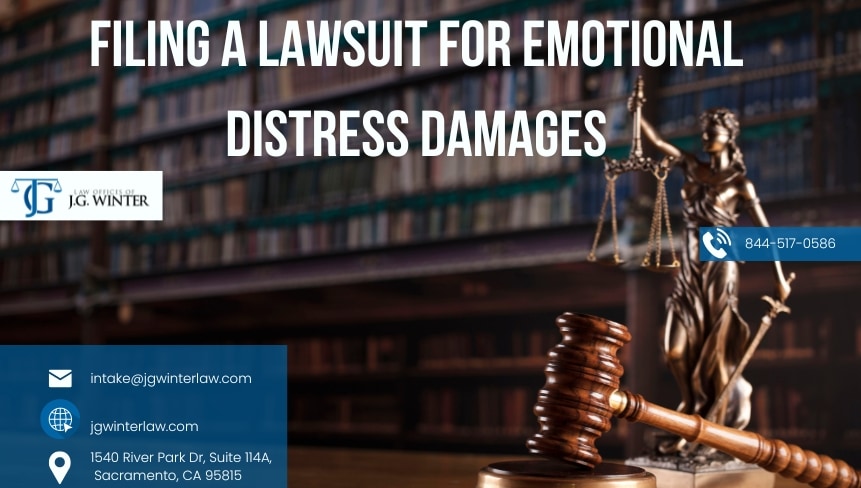Suing for emotional distress damages is a critical aspect of personal injury law that addresses the mental anguish and psychological impact of an incident. Unlike physical injuries, emotional distress can be harder to see but is just as debilitating. Recognizing emotional distress is crucial for a comprehensive approach to personal injury claims. It helps you receive full compensation for all aspects of your suffering.
What are emotional distress damages?
Emotional distress damages compensate for the psychological suffering caused by someone else’s actions, separate from physical injuries. These damages specifically address the mental impact of an incident. There are two main types of emotional distress: Intentional Infliction and Negligent Infliction.
Intentional infliction
Intentional Infliction of Emotional Distress (IIED) is when someone purposely causes severe emotional suffering to another. It goes beyond mere insults or annoyances, profoundly disturbing your peace of mind.
- Harassment: Persistent and unwanted actions causing fear or stress.
- Bullying: Repeated aggressive behavior intended to hurt or intimidate.
- Stalking: Following or monitoring someone in a way that induces anxiety or fear.
- Threatening Behavior: Making threats that cause fear for safety or well-being.
Negligent infliction
Negligent Infliction of Emotional Distress (NIED) involves causing emotional pain unintentionally, through careless actions rather than deliberate harm. It recognizes the impact of negligence that leads to significant emotional suffering.
- Accident Negligence: Careless actions leading to accidents that cause emotional trauma.
- Indirect Emotional Harm: Actions that, while not directly targeted, result in emotional distress.
- Failure to Prevent Harm: Neglecting responsibilities that could prevent emotional suffering.
- Carelessness Causing Fear: Actions that, through negligence, instil fear or trauma in others.
How to file an emotional distress lawsuit?
Emotional distress claims can be complex, making it crucial to follow a structured approach to strengthen your case. Consulting with a personal injury attorney is crucial to filing a lawsuit for emotional distress damages. They navigate the legal system to advocate for your rights effectively and help you receive fair compensation.
Step 1: Document your emotional distress
Documenting your emotional distress includes keeping a detailed diary of your feelings, symptoms, and how your daily life is affected. Include dates and specific incidents that triggered your emotional distress. It illustrates the depth and duration of your suffering and supports your claim.
Step 2: Seek professional help
A mental health professional supports your healing process and provides an expert’s perspective on your emotional distress. They offer a professional diagnosis and treatment, which is crucial to your claim. It significantly strengthens your case, providing evidence of the seriousness of your emotional distress.
Step 3: Consult with a personal injury attorney
A personal injury attorney can evaluate the strength of your claim, guide you through the legal process, and advise you on the best course of action. They gather the necessary evidence and formulate a strong legal strategy.
Step 4: File your claim
Your attorney will help you file your claim. They prepare and submit legal documents to the court, and outline your case against the defendant. The filing details the nature of your emotional distress, the cause, and the compensation you seek. Attorney Jeremy Gordon Winter can help you navigate the complexities of claiming emotional distress damages. Our personal injury lawyers support and guide you throughout the process and help you secure the justice and compensation you deserve.
Step 5: Prepare for court
Work closely with your personal injury lawyer to develop a compelling case presentation. It may include rehearsing your testimony, reviewing the evidence, and understanding the legal arguments. Your attorney guides you through the process, ensuring you are ready to present your case effectively.
Criteria for filing emotional distress claims
You must meet specific legal criteria to file a successful claim for emotional distress damages. The process involves showing how the distress has affected daily life and establishing a clear connection to the defendant’s action.
- Witnessing a traumatic event: You may be entitled to claim emotional distress if you witness a traumatic event, like a severe accident or crime. The law recognizes claims for emotional distress if the impact is deep and long-lasting, affecting your ability to lead a normal life.
- Direct victim of harassment or bullying: If you suffer ongoing harassment, intimidation, or bullying, you may qualify for emotional distress damages. You must demonstrate a pattern of behavior that intentionally caused significant emotional harm.
- Loss of a loved one due to negligence: In cases where a family member dies because of someone else’s negligence, the surviving family can claim emotional distress. These claims must show that the emotional suffering is directly linked to the negligence.
Each of these situations requires careful documentation to prove your emotional distress and its direct relation to the defendant’s actions.
Evidence to support emotional distress claims
Presenting compelling evidence is crucial to build a strong emotional distress claim. It demonstrates the severity of the emotional suffering and links it directly to the incident.
- Medical records: Include therapy sessions, psychiatric treatment, and medication prescribed for mental health issues. These documents prove your emotional distress and its ongoing impact.
- Personal diary or journal: Entries detailing the daily emotional struggles provide a personal account of the distress. It offers insight into the claimant’s mental and emotional state over time.
- Witness statements: Testimonies from family, friends, or colleagues who have observed your suffering can support the emotional impact.
- Expert testimony: Mental health professionals can offer opinions on your condition, drawing connections between the distress and the incident.
Calculating emotional distress damages
Calculating damages for emotional distress involves a nuanced process, as the impact of emotional suffering isn’t as straightforward to quantify as physical injuries. Unlike medical bills or lost wages, there’s no direct financial metric to measure the depth of someone’s emotional pain and suffering. It underscores the necessity of legal expertise in effectively presenting and arguing for fair compensation.
- Pain and Suffering: Compensation for pain and suffering covers the physical discomfort and diminished quality of life resulting from an injury. It evaluates the intensity of your pain and its duration.
- Loss of Enjoyment of Life: If you can’t do your favorite activities or enjoy time with family and friends like before, this compensation is for those missed happy moments.
- Loss of Relationships: Sometimes, the stress affects how you connect with your closest people, like your spouse. It recognizes what’s lost in your personal connections.
- Money for Future Therapy: Healing from emotional pain often means talking to a therapist or counselor. This part of the compensation helps pay for those future visits.
J.G. Winter Law to pursue an emotional distress claim

Filing a lawsuit for emotional distress damages is a step towards healing and justice. However, you must navigate the process with the right support and expertise to protect your rights and secure a fair settlement. J.G. Winter Law provides you with professional guidance and support to file a lawsuit for your emotional distress. Our personal injury lawyers make the legal process as clear and straightforward as possible and support you every step of the way. Contact us today and begin your journey toward recovery and restitution.
FAQs
What is considered emotional distress?
Emotional distress refers to the suffering from the psychological effects an incident caused. It can include anxiety, depression, trauma, or grief. It’s not just about being upset; it’s a significant impact on one’s mental health and well-being.
What are examples of emotional distress?
Examples of emotional distress can include:
- Severe anxiety or panic attacks
- Depression or prolonged sadness
- Post-traumatic stress disorder (PTSD)
- Insomnia or other significant sleep disturbances
- Loss of enjoyment of life
Is emotional distress a personal injury?
Emotional distress is considered a personal injury legally. While personal injury typically refers to physical harm, the law recognizes that severe emotional suffering can also be a significant injury.
Can I sue for emotional distress?
Yes, you can sue for emotional distress if you experience severe mental suffering due to another party’s negligent or intentional actions. To succeed, you must show a direct link between their behavior and your distress. Legal standards and requirements for emotional distress claims vary by jurisdiction.
What is the most you can sue for emotional distress?
The maximum amount you can sue for emotional distress varies widely depending on the specifics of the case, jurisdiction, and the severity of the distress. Some cases have resulted in substantial settlements or awards, but there’s no fixed maximum limit as it depends on the individual case.
What evidence do you need for emotional distress?
Evidence to support a claim for emotional distress might include:
- Medical records from mental health professionals
- Testimonies from therapists, psychologists, or psychiatrists
- Personal journals or diaries
- Testimonies from witnesses
- Proof of therapy or counseling
What case can you file for emotional damage?
You can file a personal injury lawsuit for emotional damage, specifically under claims such as intentional infliction of emotional distress (IIED) or negligent infliction of emotional distress (NIED), depending on the nature of the incident that caused the emotional distress.


